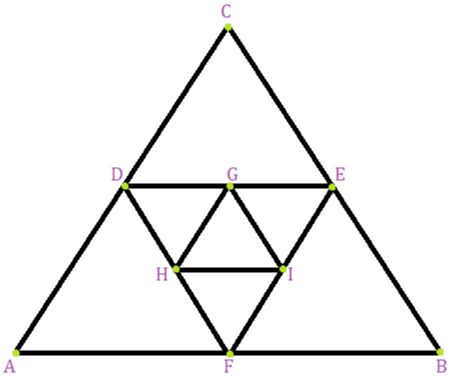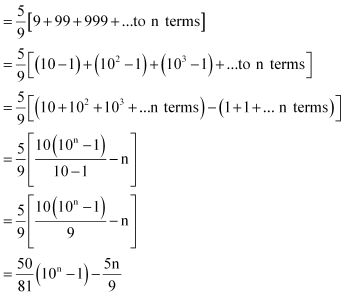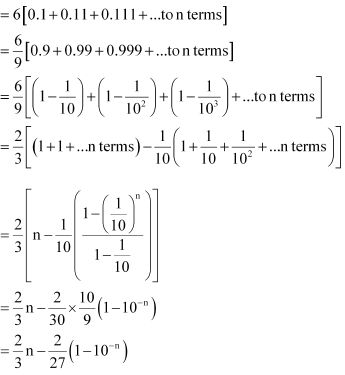- Books Name
- AMARENDRA PATTANAYAK Mathmatics Book
- Publication
- KRISHNA PUBLICATIONS
- Course
- CBSE Class 11
- Subject
- Mathmatics
Geometric Progression (GP) and Geometric Mean (GM)
A sequence a1, a2, a3,…, an,… is called Geometric sequence or Geometric progression
if an + 1 / an = r, n Î N, where a1 is called the first term and the constant term r is called
the common ratio of the G.P.
It is represented by:
a, ar, ar2, ar3, ar4, and so on.
Where a is the first term and r is the common ratio.
The nth term of a GP is an=Tn = arn-1
a = the first term, r = the common ratio, l = the last term,
n = the numbers of terms,
Sn = the sum of first n terms.
Suppose a, ar, ar2, ar3,……arn-1 is the given Geometric Progression.
Then the sum of n terms of GP is given by:
Sn = a + ar + ar2 + ar3 +…+ arn-1
- Sn = a[(rn – 1)/(r – 1)] if r ≠ 1 and r > 1
Types of GP:
- Finite geometric progression (Finite GP)
- Infinite geometric progression (Infinite GP)
Finite Geometric Progression
The terms of a finite G.P. can be written as a, ar, ar2, ar3,……arn-1
a, ar, ar2, ar3,……arn-1 is called finite geometric series.
The sum of finite Geometric series is Sn = a[(rn – 1)/(r – 1)] if r ≠ 1 and r > 1
Infinite Geometric Progression
Terms of an infinite G.P. can be written as a, ar, ar2, ar3, ……arn-1,…….
a, ar, ar2, ar3, ……arn-1,……. is called infinite geometric series.
The sum of infinite geometric series is Sn = ![]()
Properties of GP:
- Three non-zero terms a, b, c are in GP if and only if b2 = ac
- In a GP,
Three consecutive terms can be taken as a/r, a, ar
Four consecutive terms can be taken as a/r3, a/r, ar, ar3
Five consecutive terms can be taken as a/r2, a/r, a, ar, ar2 - In a finite GP, the product of the terms equidistant from the beginning and the end is the same
That means, t1.tn = t2.tn-1 = t3.tn-2 = ….. - If each term of a GP is multiplied or divided by a non-zero constant, then the resulting sequence is also a GP with the same common ratio
- The product and quotient of two GP’s is again a GP
- If each term of a GP is raised to the power by the same non-zero quantity, the resultant sequence is also a GP
- If a1, a2, a3,… is a GP of positive terms then log a1, log a2, log a3,… is an AP (arithmetic progression) and vice versa
Geometric Mean (G .M.) : The geometric mean of two positive numbers a and b is the
Number √(ab).
Therefore, the geometric mean of 2 and 8 is 4.
We observe that the three numbers 2,4,8 are consecutive terms of a G.P.
Let G1, G2,…, Gn be n numbers between positive numbers a and b such that
a,G1,G2,G3,…,Gn,b is a G.P.
Thus, b being the (n + 2)th term,
we have b= arn+1

Example: Insert three numbers between 1 and 256 so that the resulting sequence
is a G.P.
Solution Let G1, G2,G3 be three numbers between 1 and 256 such that
1, G1,G2,G3 ,256 is a G.P.
Therefore 256 = r4 giving r = ± 4 (Taking real roots only)
For r = 4, we have G1 = ar = 4, G2 = ar2 = 16, G3 = ar3 = 64
Similarly, for r = – 4, numbers are – 4,16 and – 64.
Hence, we can insert 4, 16, 64 between 1 and 256 so that the resulting sequences are in G.P.
Relationship Between A.M. and G.M.:
Let A and G be A.M. and G.M. of two given positive real numbers a and b, respectively.

Thus, we have


- A – B ³ 0
we obtain the relationship A ![]() G.
G.
Example 1. We know the sum of the interior angles of a triangle is 180°. Show that the sums of the interior angles of polygons with 3, 4, 5, 6, … sides form an arithmetic progression. Find the sum of the interior angles for a 21-sided polygon.
Solution:
Given the sum of interior angles of a polygon having ‘n’ sides is given by (n – 2) × 180°
Sum of angles with three sides that is n = 3 is (3 – 2) × 180° = 180°
Sum of angles with four sides that is n = 4 is (4 – 2) × 180° = 360°
Sum of angles with five sides that is n = 5 is (5 – 2) × 180° = 540°
Sum of angles with six sides that is n = 6 is (6 – 2) × 180° = 720°
As seen as the number of sides increases by 1 the sum of interior angles increases by 180°
Hence the sequence of sum of angles as number of sides’ increases is 180°, 360°, 540°, 720° …
The sequence is AP with first term as a = 180° and common difference as d = 180°
We have to find sum of angles of polygon with 21 sides
Using (n – 2) × 180°
⇒ Sum of angles of polygon having 21 sides = (21 – 2) × 180°
⇒ Sum of angles of polygon having 21 sides = 19 × 180°
⇒ Sum of angles of polygon having 21 sides = 3420°
Example 2. A side of an equilateral triangle is 20cm long. A second equilateral triangle is inscribed in it by joining the mid points of the sides of the first triangle. The process is continued as shown in the accompanying diagram. Find the perimeter of the sixth inscribed equilateral triangle.
Solution:

Let ABC be the triangle with AB = BC = AC = 20 cm
Let D, E and F be midpoints of AC, CB and AB respectively which are joined to form an equilateral triangle DEF
Now we have to find the length of side of ΔDEF
Consider ΔCDE
CD = CE = 10 cm … D and E are midpoints of AC and CB
Hence ΔCDE is isosceles
⇒ ∠CDE = ∠CED … base angles of isosceles triangle
But ∠DCE = 60° …∠ABC is equilateral
Hence ∠CDE = ∠CED = 60°
Hence ΔCDE is equilateral
Hence DE = 10 cm
Similarly, we can show that GH = 5 cm
Hence the series of sides of equilateral triangle will be 20, 10, 5 …
The series is GP with first term a = 20 and common ratio r = ½
To find the perimeter of 6th triangle inscribed we first have to find the side of 6th triangle that is the 6th term in the series
nth term in GP is given by tn = arn-1
⇒ t6 = (20) (1/2)6-1
⇒ t6 = 20/ 25
= 20/ (4 × 23)
⇒ t6 = 5/8
Hence the side of 6th equilateral triangle is 5/8 cm and hence its perimeter would be thrice its side length because it’s an equilateral triangle
Perimeter of 6th equilateral triangle inscribed is 3 × 5/8 = 15/8 cm
Example 3: Find the sum of GP: 10, 30, 90, 270 and 810, using formula.
Solution: Given GP is 10, 30, 90, 270 and 810
First term, a = 10
Common ratio, r = 30/10 = 3 > 1
Number of terms, n = 5
Sum of GP is given by;
Sn = a[(rn – 1)/(r – 1)]
S5 = 10[(35 – 1)/(3 – 1)]
= 10[(243 – 1)/2]
= 10[242/2]
= 10 × 121
= 1210
Check: 10 + 30 + 90 + 270 + 810 = 1210
Example 4: If 2, 4, 8,…., is the GP, then find its 10th term.
Solution: The nth term of GP is given by:
2, 4, 8,….
Here, a = 2 and r = 4/2 = 2
an = arn-1
Therefore,
a10 = 2 x 210 – 1
= 2 × 29
= 1024
Example 5. Find the sum of the following series up to n terms:
(i) 5 + 55 + 555 + … (ii) .6 + .66 + . 666 + …
Solution:
(i) Given, 5 + 55 + 555 + …
Let Sn = 5 + 55 + 555 + ….. up to n terms

(ii) Given, .6 + .66 + . 666 + …
Let Sn = 06. + 0.66 + 0.666 + … up to n terms

The Geometric Mean (G.M.) of a set of n observations is the nth root of their product. If x1, x2, ... , xn are n observations then

Example: If AM and HM of the data sets are 4 and 25 respectively, then find the GM.
Ans:
Given that, AM = 4
HM = 25.
We know that the relation between AM, GM and HM is
GM = √[ AM × HM]
Now, substitute AM and HM in the relation,
we get;
GM = √[4 × 25]
GM = √100 = 10
Hence, GM = 10.

 KRISHNA PUBLICATIONS
KRISHNA PUBLICATIONS
